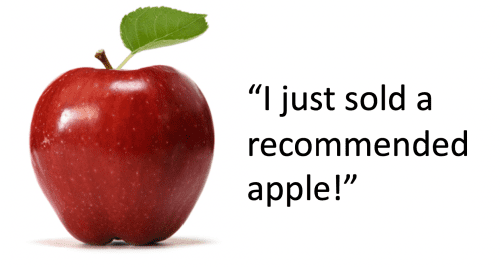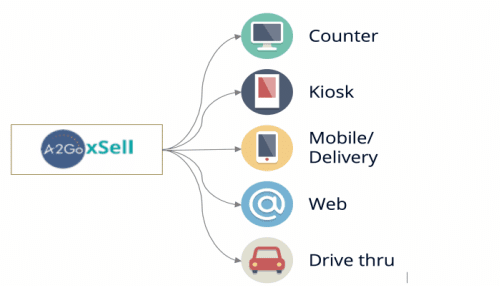Rafael Fanchini, Chief Product Officer
Analytics2go.com

Value meals (groups of menu items offered together at a lower price than they’d cost individually) are a key strategic marketing instrument for QSR brands because customers like the savings. But lower prices mean lower margins for the stores. Today’s brands are starting to see the value in cross-selling as a means to increase ticket size and offset the discounts inherent in the value meals. Because QSR restaurants are distinguished from other types by their quickness, cashiers—whether in-person or digital guides at kiosks and online—are hard pressed to recommend other choices than the usual recommended by their managers: French fries, a soda, and some dessert. Yet we all know that consumers’ tastes change as they learn more about health foods and foodstuff trends. So, stores that provide pairings that are more likely what a customer would want they are more attractive if recommended.
The key here is “recommended.” To understand the complexity faced by sales personnel in the in-person and drive-thru channels, it is important to understand what is required of a salesperson to complete each order. Currently, to make a product recommendation, salespeople must use their intuition at the correct moment to recommend an item to each customer or simply follow a recommendation set by the manager to recommend the same item to all lunch or dinner orders, for instance.
We know that effective cross-selling for QSRs requires speed, contextualization, and personalization to be successful. Customers want only to be asked if they would like to order something that they are likely to order vs. being asked if they want fries when they just ordered ice cream. This means that every combination of items and the context in which they are being ordered can generate a different product recommendation, making it untenable for salespeople to handle.
But if cross-selling is the QSR industry’s ticket to more revenue and profitability, how can it meet this challenge of finding the right recommendation for a particular customer or customer population in a particular region within each store’s inventory of foodstuffs on hand?
By now, you have probably guessed that the answer lies in AI, which offers the quantification for these qualities and the prediction capabilities needed to solve such a multi-pronged challenge. To determine the most likely additional item to be purchased, data such as the date, the time, the weather, the location, the local events calendar, and the POS data from that store are all brought together to calculate the best item to recommend to each customer’s order.
The solution that my original company in Brazil, teamed with Analytics2Go in the US to develop, is now called A2Go xSell (http://www.xsell.analytics2go.com). It is an AI-based system specialized for the QSR industry, providing highly relevant cross-sell recommendations for every sale in every channel without impacting sales time—with impressive results.

The Discovery Process
We conducted our first experiment in a drive-thru store. As usual in every transformational process, the most challenging part was related to change management, but at some point, all the key pieces between IT, Marketing, and Operations were aligned and a pilot was enabled. An increase in sales emerged right away. As results were confirming expectations and executives were becoming familiar with how the technology works, business-driven questions and challenges naturally arose. At one point we got a very challenging request: to change the recommendation algorithm to stop recommending apples!
You can imagine how surprising this was to all! But it’s true: The AI model learned from the store’s historical data that in some not-so-unusual situations an apple was the best product to recommend during a cross-selling moment. The owner thought this could not be “true”: maybe something was wrong with the model we had established, he theorized. He was worried that the store would be losing valuable opportunities to recommend better products. Despite his worries, I had confidence in the model and that confidence was verified by a cashier who told the store management the next day, “I just sold a recommended apple, and the customer was delighted.”
The apple case as well as all other recommended products sold are compelling signs of an important transformation on how QSR brands can cross-sell successfully using AI. Since any change in a human-based sales process is complex and sensitive, the pilot relied on what we at A2Go call “a primary approach” that provided recommendations only at the end of the sales process. Based on this approach, cashiers were oriented to simply exchange the common final question, “Anything else?” with a value-inspiring question like, “How about an ice cream for $3?” The ice cream was recommended by the A2Go xSell solution. It popped up on the POS screen at the cashier station. This approach virtually avoids any change in the existing culture and sales process, which makes adoption a very simple and smooth process.
Results achieved with this primary approach suggest it can consistently generate 3 – 5% of incremental sales to offline channels. For digital channels, we’re starting a pilot with different companies now, and the evidence shows the reward is even greater—increasingly important to the new world impacted by COVID-19.
Gaining Higher Returns
Once the primary approach is in place, the initial value is unleashed, and the sales increase is confirmed, it’s time to expand the value by taking A2Go xSell to the whole offline sales process through what we call “a complete approach.”
In this approach, A2Go xSell is fully embedded in the entire offline sales process to manage all products to be recommended to customers over the sales journey. The solution excludes products that are out of stock or low in inventory and prioritizes recommendations of specials when appropriate, also monitoring each salesperson’s success with the recommendations. It also offers real-time tracking of profits due to A2Go xSell recommendations. By doing this, brands become able to operate a very systematic process where humans are solely responsible for embracing and serving customers, while AI provides the best products to be recommended over the journey. This is a strong example of collaborative learning where we combine the best of AI (analytical capability) with the best of human expertise (creativity and socialization) to optimize the outcome.
In the complete approach, AI-human collaboration, automation, and a whole new environment of granular performance indicators comprise the landscape for sales increase to reach 10%. But more than that, since sales increase is purely enabled by technology, net revenue is an even bigger number, since no investment in marketing or operational change is necessary.
Rafael Fanchini 1 305 763-1905.
